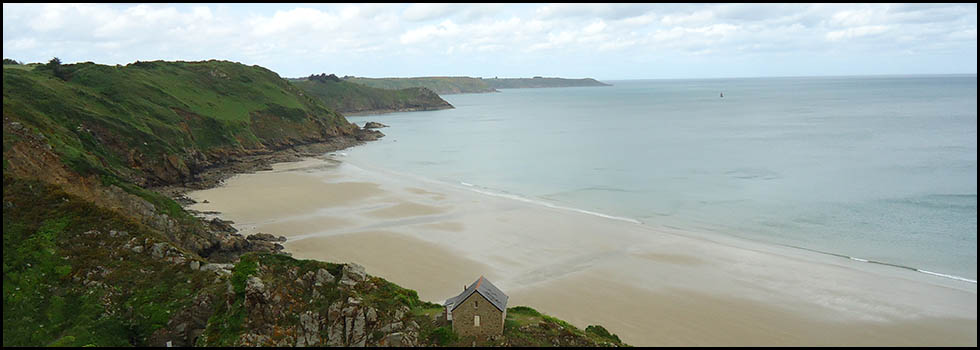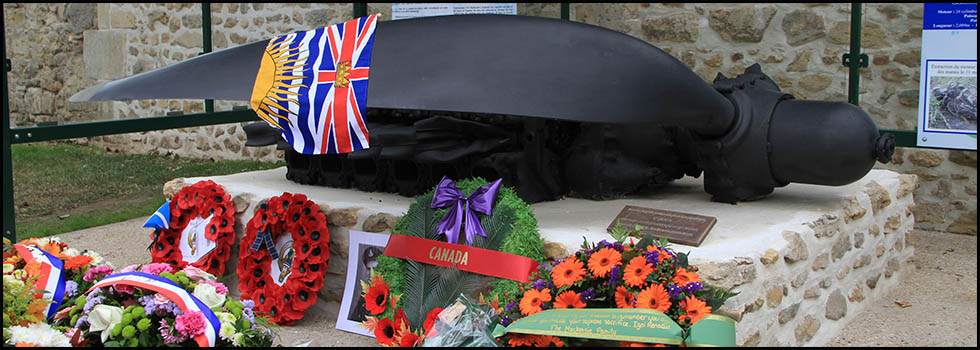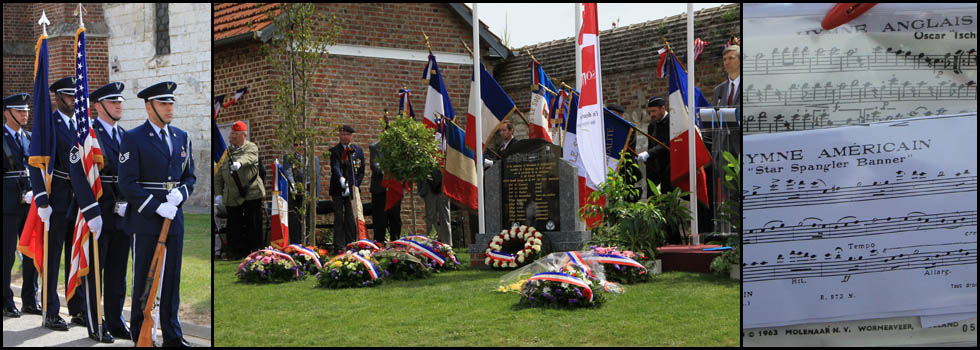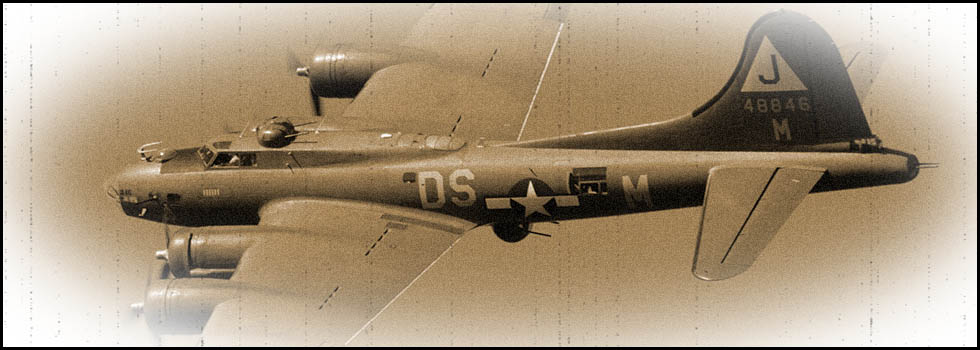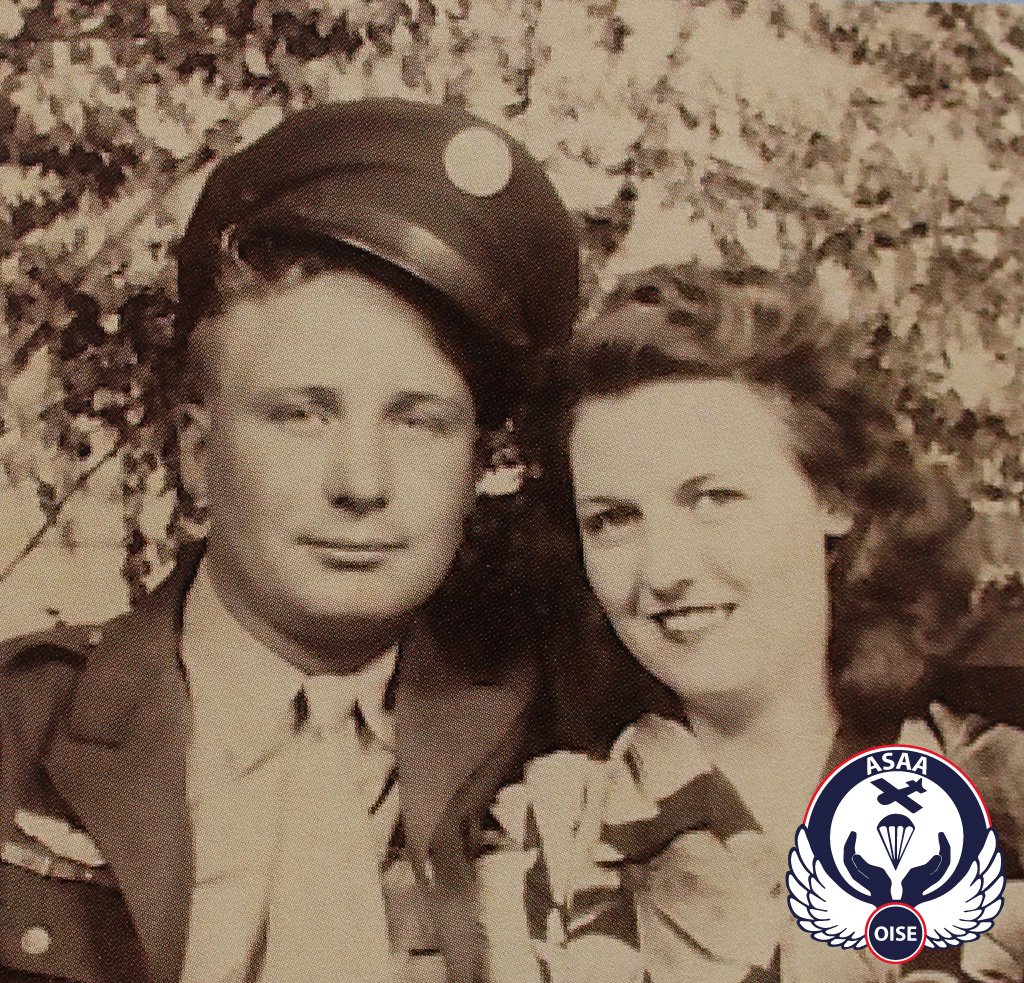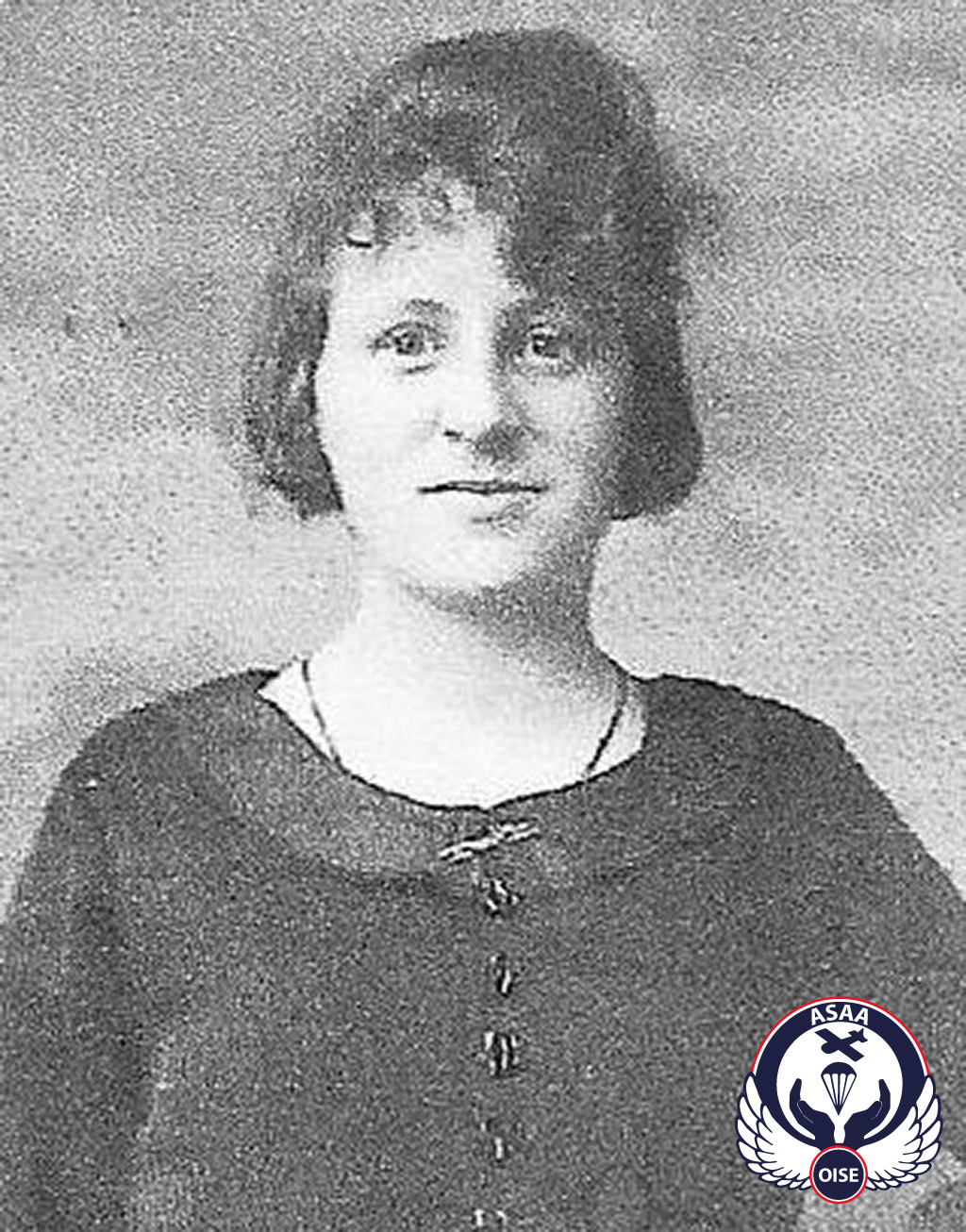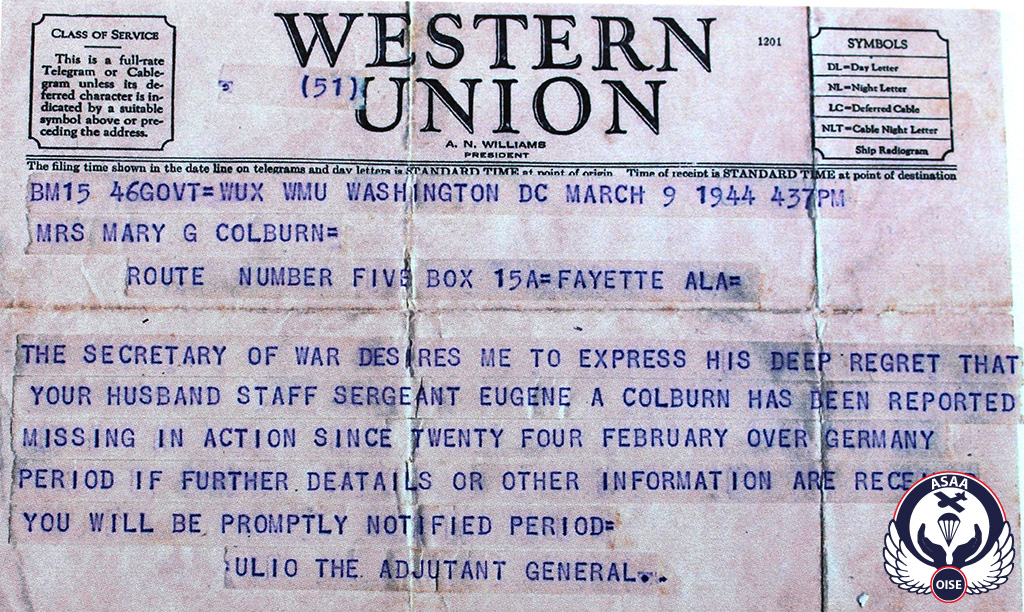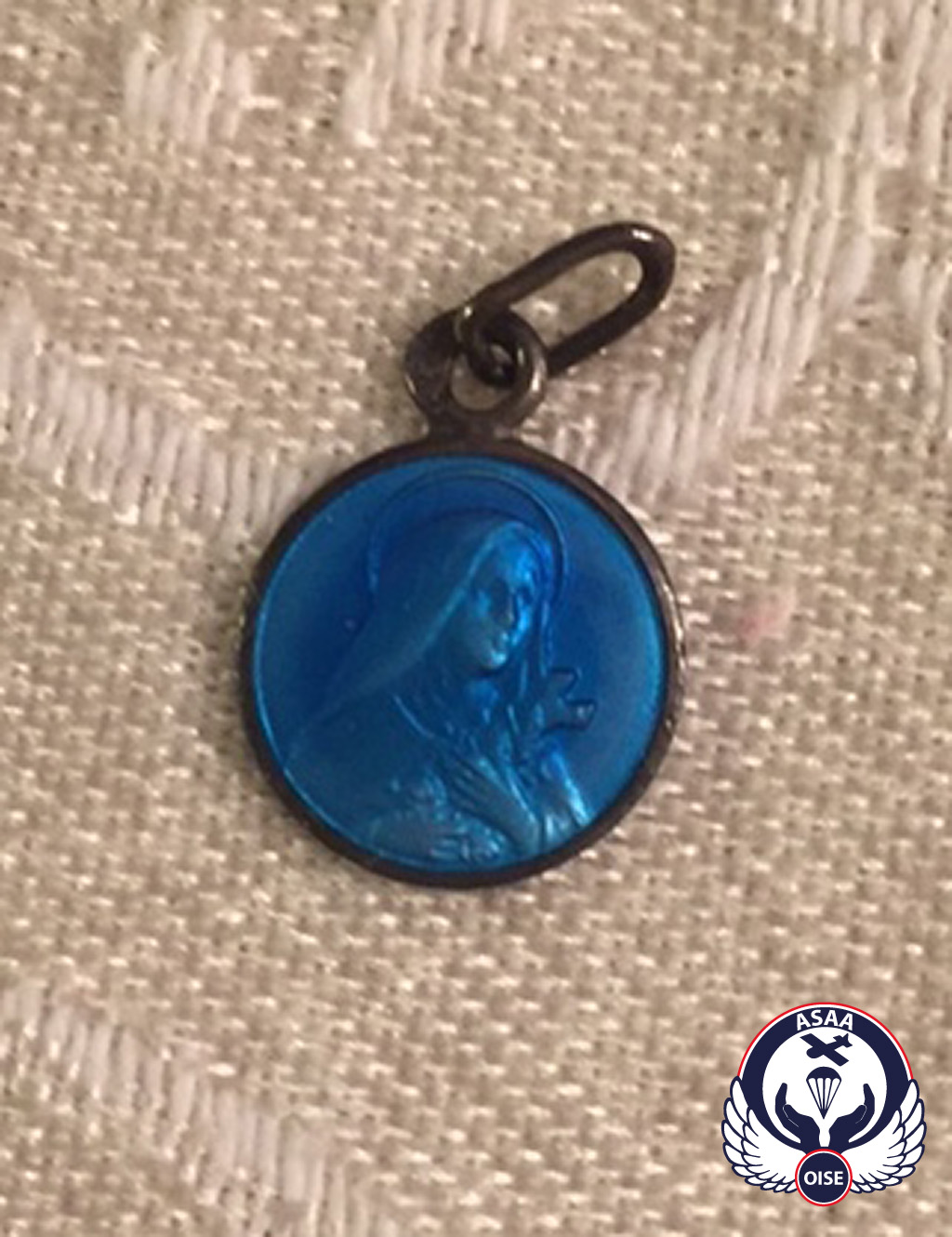24th February 1944
S/Sgt Eugene A. COLBURN
B-17F # 42-3517 “Happy Warrior”
351st Bomb Group
508th Bomb Squadron
8th Air Force
Grattepanche (Somme)

S/Sgt. Eugene A. COLBURN
Eugene A. Colburn was born on 27th February 1921 at Rock City, Alabama.
When war was declared in December 1941, he was a worker in a sawmill.
In August 1942, a month after the death of his father, he decided to enlist in the U.S. Army Air Corps. After several months of training on various U.S. bases, he graduated as a gunner and joined the crew of a Boeing B-17 "Flying Fortress" in the 351st Bomb Group of the 8th Air Force. All newly trained crews were then ready to go to Great Britain, ready to replace or supplement the crews who were already fighting in the uncertain skies of Europe.
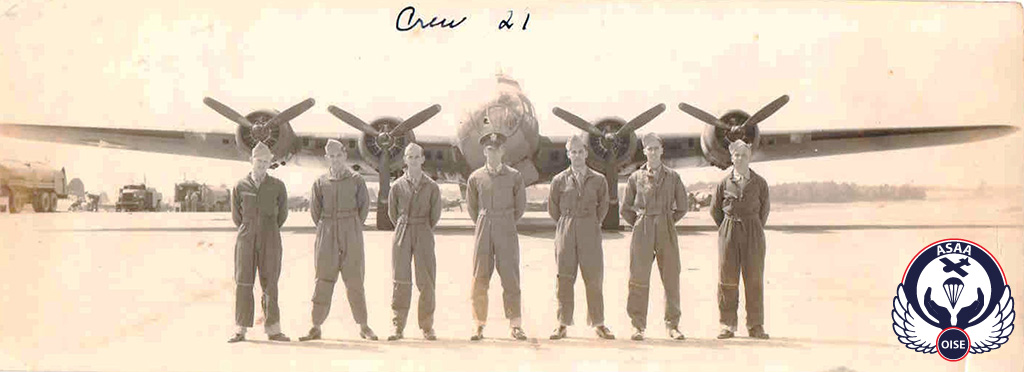
From left to right : George Bond, John Mattila, William Nolen, Richard Caughman, Morton Barrell, Howard Langer and Eugene Colburn
In July 1943, he married his fiancée Mary whom he had met in 1941.
Eugene Colburn and his wife Mary
Then followed the difficult time of separating from his wife, his mother and his three younger brothers. S/Sgt. Eugene A. Colburn joined Camp Kilmer, New Jersey. On 9th August 1943, a month to the day after his wedding and together with hundreds of other recruits, he boarded a luxury British liner converted to a troop carrier, to England. After crossing the Atlantic, the ship docked in the port of Liverpool. S/Sgt. Eugene A. Colburn went to Polebrook, Northamptonshire, where the 351st Bomb Group took part in the campaign of strategic bombing over enemy territory.
On 24th February 1944, the crew that included S/Sgt. Eugene A. Colburn was down to carry out his 10th mission. During the morning briefing, the target of the day was revealed : Schweinfurt, in the heart of Germany, a city particularly targeted during this "Big Week" which had started four days previously. The massive bombing raids by the USAAF in daylight and by night by the Royal Air Force had then intended to minimize as much as possible the enemy's aviation capacity.
The crew of the B-17 # 42-3517 "Happy Warrior", 351st Bomb Group, 508th Bomb Squadron.
| 1st Lt. Richard B. CAUGHMAN | Pilot | 23 | Evaded | Columbia, South Carolina |
| 2nd Lt. John V. BOEHM | Co-pilot | POW | Hutchinson, Kansas | |
| 1st Lt. John B. AVERY | Navigator | 25 | Evaded | Asheville, North Carolina |
| 1st Lt. Richard E. S. PERKINS | Bombardier | POW | Rexbury, Massachusetts | |
| S/Sgt. Eugene C. STRASSBURGER | Top turret gunner | 21 | KIA | Wauwatosa, Wisconsin |
| T/Sgt. John C. MATTILA | Radio-operator | 20 | Evaded | Farwell, Minnesota |
| S/Sgt. Paul B. YOUNG | Ball turret gunner | 22 | Evaded | San Francisco, California |
| S/Sgt. Eugene A. COLBURN | Right waist gunner | 23 | Evaded | Bankston, Alabama |
| S/Sgt. Howard M. LANGER | Left waist gunner | POW | Arverne, New York | |
| Sgt. James W. McGINTY | Tail gunner | 25 | Evaded | Visalia, California |
Each loaded with 12 bombs of 500 pounds, the fifteen aircraft of the 351st Bomb Group took off under a hazy sky. Having got into formation, they joined the huge armada of over 230 bombers which set course for Germany.
Over the English Channel, the "Happy Warrior" piloted by 1st Lt. Caughman ran into difficulties since one of the four engines caught fire. To extinguish the flames, the pilot turned off the fuel supply. Powered now by only three engines, the bomber struggled to stay in the formation.
Over a lake of the Zuiderzee, Holland, the aircraft dropped its bombs. The order was given to the pilot to continue the mission to ensure the protection of the other bombers by the fire from its machine guns.
Arriving over Germany, the formation came under fire from Flak. The aircraft progressed amid terrible explosions of enemy anti-aircraft shells that damaged the "Happy Warrior". After flying over the target, the doomed Flying Fortress managed to get back over France but the damage forced the pilot to give the order to evacuate the aircraft over the Somme.
The ten crew members were able to leave their posts and managed to bale out.
S/Sgt. Eugene A. Colburn saw with horror that one of the parachutes did not open. S/Sgt. Eugene C. Strassburger, after a hair-raising fall was sent to a horrible death.
Tumbling into the void and into the cold, S/Sgt. Colburn lost his watch and his wedding ring during the descent. After managing to deploy his parachute, he finally made a hard landing in a snowy field in the Picardy countryside. The impact with the ground made him lose consciousness for several minutes. Safe and sound, he found himself isolated. None of his companions in misfortune had landed nearby.
The abandoned aircraft, continuing its flight, crashed near the village of Grattepanche in the "departement" of the Somme between Amiens and Ailly-sur-Noye.
Regaining his senses, S/Sgt. Colburn saw a French couple watching him. The man was holding a fork and helped him to quickly get out of his parachute and then showed him a wood where he could hide. By late afternoon, he found refuge in a haystack, trying to protect himself from the cold. In the night, on a nearby road, he saw trucks full of German soldiers who were looking for the airmen.
S/Sgt. Colburn testified later that during the night, the intense cold and fear of discovery prevented him from sleeping. Unaware exactly where he was, he could now only trust to luck.
At dawn the following day, he came out of his hiding place and made his way South with the help of his compass. He went alongside the Amiens to Paris railway line, hiding from time to time in the woods.
He moved thus for several days, eating potatoes, sugar beets or carrots that the farmers stocked in silos across the country.
Eventually, S/Sgt. Colburn crossed into the “departement” of Oise. An old man, requisitioned by the Germans to look after the tracks along the railway line, shared with him the little food he had. He pointed out a house located high up in the nearby village. S/Sgt. Colburn decided to go there. He was greeted by an old woman and her family who offered meat, raw eggs and black bread to the hungry airman. He quickly got rid of his flying suit which was then buried. In exchange, he put on peasant clothes. According to some postwar correspondence, the people who collected S/Sgt. Colburn were very likely to have been Theo and Marie Brochart in the village of Mory-Montcrux (Oise).
After a certain time, he was passed on to the Maillard family who lived in a farm situated a few steps away, right next to the church. Paul Maillard and his wife Renee lodged S/Sgt. Colburn for a fortnight in spite of all the risks from the enemy in the region. During his stay the airman spent his time cutting wood and helping with work around the farm.
Paul Maillard and his wife Renée
March 1944
S/Sgt. Colburn photographed at the Maillard family farm.
During the month of March, John Stewart, a radio-electrician of English origin and a member of the Resistance of the town of Saint Just-en-Chaussee came to interrogate S/Sgt. Colburn to make sure he was not a spy infiltrated by the Germans.
S/Sgt Colburn was not the only airman rescued in the village of Mory-Montcrux. 1st Lt. Harry F. Hunter, a P-47 “Thunderbolt" fighter pilot of the 353rd Fighter Group of the 8th Air Force, shot down on 30th May 1944 during an attack on the station of Montdidier, was also taken in by the Maillard family.
Meanwhile, in the United States :
On the 9th March 1944, a taxi arrived at the house of Mary, the wife of S/Sgt. Colburn. The driver handed her a telegram from Western Union. What would it tell her ? Broadcast information about the war in Europe was terrifying. Worried, Mary opened the paper with trembling hands. It announced the missing in action of her husband since 24th February. There was no additional information. "Missing in action !” But was he still alive ? Was he a prisoner of the Germans ? Had he been rescued by the Resistance in the occupied territories ?
Mary’s younger brother brought the telegram to Eugene’s mother. It only remained for the family to pray and hope.
However, his wife Mary never abandoned hope. She remained convinced that her husband would reappear one day. She bought War bonds as often as possible to support her country with the War effort.
John Stewart appeared again at Mory-Montcrux a few days later and took S/Sgt. Colburn by bicycle to Saint-Just-en-Chaussee. Before his departure, an old woman handed the young airman a small medallion of the Virgin, sewn into a handkerchief so it would protect him. He would keep it all his life.
At Saint-Just-en-Chaussee, S/Sgt. Colburn was entrusted to Jean Crouet, known as "John Weeks" in the Resistance. He was also a chemical engineer at the Weeks plant. Jean Crouet and his wife Madeleine sheltered the airman for about a week before transferring him to the home of Leon Hary, a baker in town.
During his stay in Saint Just-en-Chaussee, Eugene A. Colburn was surprised to meet one of his countrymen, Sgt. Charles F. Payne, brought by Dr. Edmond Caillard.
Editor's note : the escape of Sgt. Payne has already been published on our website. He was the only survivor of the collision of two B-24 "Liberators” above the villages of Godenvillers and Le Ployron on 18th March 1944, a terrible tragedy that resulted in the death of 19 of his countrymen. After Saint-Just-en-Chaussee, Sgt. Payne and S/Sgt. Colburn were bound by the same fate. It is therefore appropriate to recall that part of their common escape.
On Wednesday 22nd March, Sgts. Colburn and Payne were taken by Dr. Caillard to Bulles where they were lodged by Pierre Coulon. This carpenter had already taken in American airmen the previous month. He was a reliable man and totally trustworthy. During the day, the two airmen had to remain hidden in a small room upstairs in the house overlooking the joinery. They only came down in the evening for dinner. The comings and goings of the Germans meant the greatest care had to be taken.
Eugene Colburn and Charles Payne were then taken to Cressonsacq where they were housed in the farm of Henri and Simone Doisy. Jacky du Pac, Intelligence Officer, came to interrogate them to be certain they were indeed American airmen. He told them that the Gestapo was making arrests in Paris and that they needed to wait before continuing their escape.
About a week later, the two airmen were moved again. They were taken to Valere Sorel’s, a blacksmith who lived in Brunvillers-la-Motte with his wife Leonie and their 17 year old daughter Lucie. Eugene A. Colburn and Charles F. Payne remained protected by this family throughout the whole month of April, in defiance of all the risks and of all the sacrifices in these times of great shortage.
The house of the Sorel family at Brunvillers-la-Motte
A few days before the end of the month of April, Dr. Caillard came back again to get the two airmen at Brunvillers-la-Motte. He took them to Creil to his friend and colleague, Dr. Georges Debray, with whom he had several contacts. The railway junction and the aerodrome occupied by the Germans caused several bombardments of the town.
They stayed with Dr Dubray for a few hours. The same day, Edmond Bourge took Eugene A Colburn and Charles F. Payne to the village of Villers-Saint-Paul, a few kilometres from Creil. They were lodged at the house of Mme Suzanne Parizet.
During their stay in Villers-Saint-Paul, the two airmen again met Jacky du Pac who had previously interrogated them. He told them that they will be leaving in a few days. They also met a schoolmaster, Louis Morelle, who brought them books and sometimes took them to stretch their legs.
A short time afterwards, the two airmen were taken in a lorry to Nogent-sur-Oise where they were lodged by an old man, M. Leclercq.
During the second half of the month of May, they were taken by car to Chantilly to a hotel near the station.
This hotel was used as a rendezvous point. There they met two Poles as well as some other American airmen : S/Sgt. Clifford G Golke and Sgt. Cletus S. Hard, members of the crew on board a Flying Fortress shot down on the 10th April at Ercuis (Oise). For five weeks previously Golke and Hard had stayed with the Viet family at St Vaast-les-Mello.
Two guides, Patrick Hovelacque and a young woman), separated the six men into two groups of three. Colburn, Payne and Hard stayed with Patrick Hovelacque while Golke and the two Poles followed the young woman. All then took the train to Paris.
Once at the Gare du Nord in Paris, the airmen went down into the metro and then stayed in different apartments in the capital for a few days.
On 30th May, they were brought to the Gare d’Austerlitz where they took a night train to the Southwest accompanied by two young women who served as guides.
On 1st June, they arrived in Bordeaux. They were taken by car to the home of Jean Delfour, Chief of the Bordeaux Police. Two days later, together with other escapers, their journey resumed towards the mountains of the Pyrenees and Spain. Entrusted to “passeurs”, the long and difficult climb began. They managed to cross the border in the evening of 4th June.
On the Spanish side, they were stopped by Franco's Police. They were then interned in the camp of Miranda de Ebro.
Released, Colburn, Payne, and Hard reached Gibraltar on 3rd July and then flew to Bristol, England, where they landed on 4th July. All subsequently got back to the United States.
Upon his return to England, more than four months after his aircraft crashed, S/Sgt. Colburn could finally send a telegram to reassure his wife and family. The news spread quickly that he would soon return home.

But first he had to join his unit in Polebrook. He realized that all his belongings had disappeared, only a few pictures remained. After a few days on the base, he was repatriated by air to New York before returning to his wife and family in Alabama.
Eugene and Mary had four children, one son and three daughters.
Eugene resumed his job and worked in the construction industry for 36 years. Passionate about his work, he built a house for his own family. He also loved woodworking and it was not rare to see him create wooden objects just for fun.

Eugene A. Colburn spoke little of the war with his family but had however never forgotten the French families who helped him in 1944.
After the Liberation of our region, he received letters from France written by his rescuers, letters which he did not answer. Debriefed on his return to England in July 1944, he respected the commitment he had signed. He couldn’t reveal to anyone and kept secret how he had escaped from France to the despair of those who had rescued him and who wanted to have news of him.
Eugene and Mary were married for 61 years appreciating everything life had to offer, surrounded by their children and grandchildren.
Eugene A Colburn died in the hospital in Tuscaloosa on 20th July 2004, aged 83. His wife Mary died a year later.
16th September 2016 : the visit of Laura Parker, his granddaughter.

